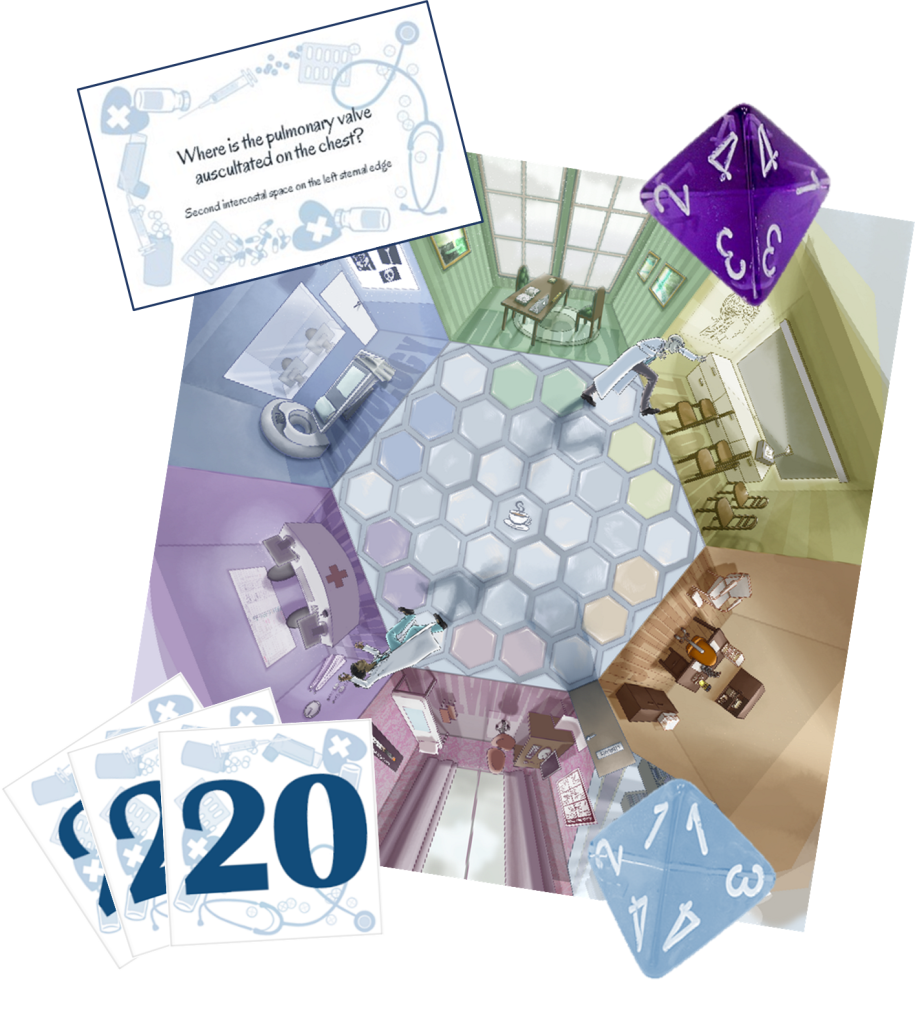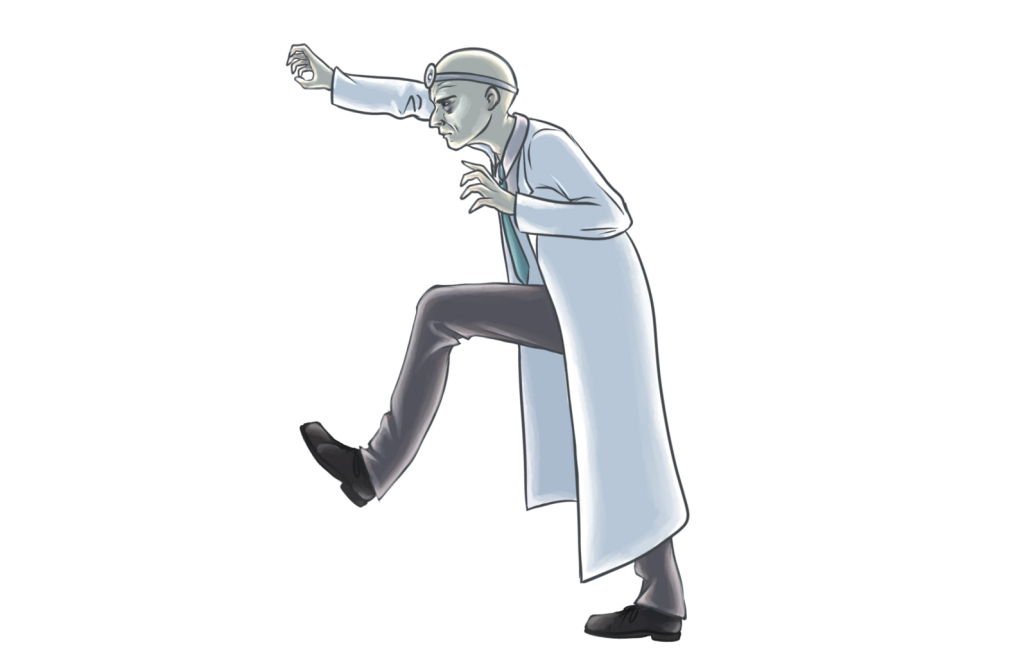Game instructions
Eleonora Leopardi and Nara Jones
Aim of the game
Solve the clinical Case Interview and examine your patient, order tests and imaging scans by moving around the Department. Use your judgement wisely, or you will run out of money before reaching a diagnosis. If you miss something, your patient’s condition may deteriorate, so be as thorough as you can.
Beware! The Spooky Consultant is just around the corner, waiting to catch you in the Department corridors. If you can’t answer their questions, you might get stuck in the Library for a while…
Game session materials

To play the game, you will need the following, which can be found at: https://bit.ly/NewcastleOER
-
Dice
Two 4-sided dice
-
Department Board
-
Case booklets
One Case booklet per student/team and related Handouts, provided in the Printable Handouts Part of this resource, or in the Diagnosis Supplementary Materials online.
-
Question cards
Approximately 250 question cards are provided in Question Cards Part of this resource, or in the Diagnosis Supplementary Materials online.. At least 20 cards per student/team should be included to avoid repetition
-
Healthcare tokens
50 Healthcare tokens
-
Game markers
One game marker per student/team
-
Facilitator Notebook
See the next section
Important
This game is best played with a facilitator. In the absence of a facilitator, each student/team can facilitate another team’s Case, and each student/team should be provided with a Facilitator Notebook.
Gameplay
Setting up
Select your facilitator, or elect to play without one (as described in Game Session Materials). Prior to the beginning of the game, each student/team randomly chooses a Case booklet. That is the Case they will have to manage to win the game. Each student/team will be given the trigger page from their booklet by the facilitator, together with a game marker, and two Healthcare tokens.
Moving on the Department Board
All students/teams position their game marker on the central tile of the Department, which is called the Break Room. In turns, they roll the dice and move their game markers on the tiles on the board, aiming to enter one of the rooms. The rooms can only be accessed from the two coloured tiles in front of the room. Moving onto a tile occupied by another student’s/team’s game marker is not allowed. Moving into a room occupied by another student’s/team’s game marker is allowed.
The rooms are:
- Red: physical examination room
- Orange: pathology laboratory
- Yellow: tutoring room
- Green: history-taking room
- Blue: radiology room
- Purple: nurses’ station/ consultation desk
Entering the rooms allows the students/teams to request medical procedures for their patients.
A detailed list of what procedures, examinations, tests and interventions are available in each room is provided in this booklet.
Requesting medical procedures
The students/teams can only request to perform the medical procedure (history-taking, physical examination, radiology tests, laboratory tests, bedside tests/specialist consult) when in the appropriate room. Each student/team can request only one procedure per turn. The procedure cost must be paid with Healthcare tokens at the moment of the request, regardless of the procedure result. The request may also be declined, should the procedure be “not indicated” or “not appropriate”; this does not constitute grounds for a refund of the procedure’s cost. The cost for procedures, including laboratory tests and imaging tests, is reported in this booklet. Tests and procedures listed on separate rows all considered separate procedures, even though they may be performed in the same room (e.g. chest X-ray and echocardiogram are two different procedures, thus they must be requested in different turns and paid for separately).
When a student/team requests a procedure, the facilitator will either ask for further details, following the instructions in the Case booklet, or provide the result. The result may consist of a brief report contained in the Case Booklet, or a more detailed report, which is provided to the student/team as a Handout. All Handouts are provided in the Printable Handouts Part of the resource, and are also available in the Diagnosis Supplementary Materials folder at http://bit.ly/NewcastleOER. If the result for a specific procedure is not contained in the Case booklet, the facilitator will let the student/team know that the procedure has yielded a “Normal Result”. The facilitator should keep track of the procedures requested by each student/team in the Facilitator notebook provided. This record allows the facilitator to know whether to provide a result again, should the student/team need to add detail to their notes. During the debriefing of the game session, it is also valuable to refer to the diagnostic process and procedures requested by the student/team, and consider areas for improvement or further learning.
Earning Healthcare tokens
In order to earn Healthcare tokens, students/teams must do tutoring service. Students/teams can do tutoring service by entering the tutoring room and answering 5 questions from the Question cards, with a time limit of 1 minute in total. Students can skip a question and return to it if there is time remaining at the end. For each question answered correctly, the student/team will receive one Healthcare token. Each Healthcare token is equivalent to $20.
The Spooky Consultant

If a student/team obtains too low of a score with their dice roll, and cannot enter any room, they remain in the corridor and fall prey of the Spooky Consultant. The Spooky Consultant will question the student/team asking them 5 questions from the Question cards, with a time limit of 1 minute in total. Students can skip a question and return to it if there is time remaining at the end.
If the student/team answers 3 or more questions correctly, they are safe and can roll the dice again to enter a room. If a student/team answers 2 or fewer correctly, they are sent to the Library (bottom right corner) to revise, and miss their turn. On their next turn, they are able to leave the Library, and start again from the Break Room. Students/teams may enter any room, even if they do not request any procedures for the room, in order to avoid the Spooky Consultant.
Deterioration clause
Each Case contains a unique deterioration clause, which is triggered after five turns. The turn that triggers the deterioration clause is indicated by a light colour shading in the Facilitator Notebook.
At the end of that turn, the facilitator reads the deterioration clause for the patient, contained in the Case booklet, and verifies whether the student has met the condition described in the deterioration clause, which means that the patient has deteriorated. If the patient has deteriorated, the student/team managing the patient must perform a knowledge check by answering 5 questions from the Question Cards, with a time limit of 1 minute in total. Students can skip a question and return to it if there is time available.
If the student/team answers all 5 questions correctly, they have rescued the patient, and can continue playing normally. If they do not answer all 5 questions, they must seek help to rescue the patient by meeting the requirement in the deterioration clause; should they be unable to do so, they will receive the penalty indicated.
Handing over
Once a student/team believes they have reached the correct diagnosis and identified the appropriate management for their patient, they are given 1 minute to prepare and 2 minutes to present their handover. A successful handover contains all the 5 sections of the ISBAR format and includes at least four of the 5 key elements listed in the sample handover provided in the Case booklet. The facilitator assesses the handover.
Winning the game
The first student/team to diagnose their patient correctly and provide a successful handover wins the game. Other students/teams may continue to play.
If a student/team misdiagnoses their patient, they have harmed or killed their patient and they lose.
If a student/team diagnoses their patient correctly but provides an incomplete handover, they can attempt the handover again in the next turn or conduct further assessments. Once a complete handover is delivered, the team has completed the game.

